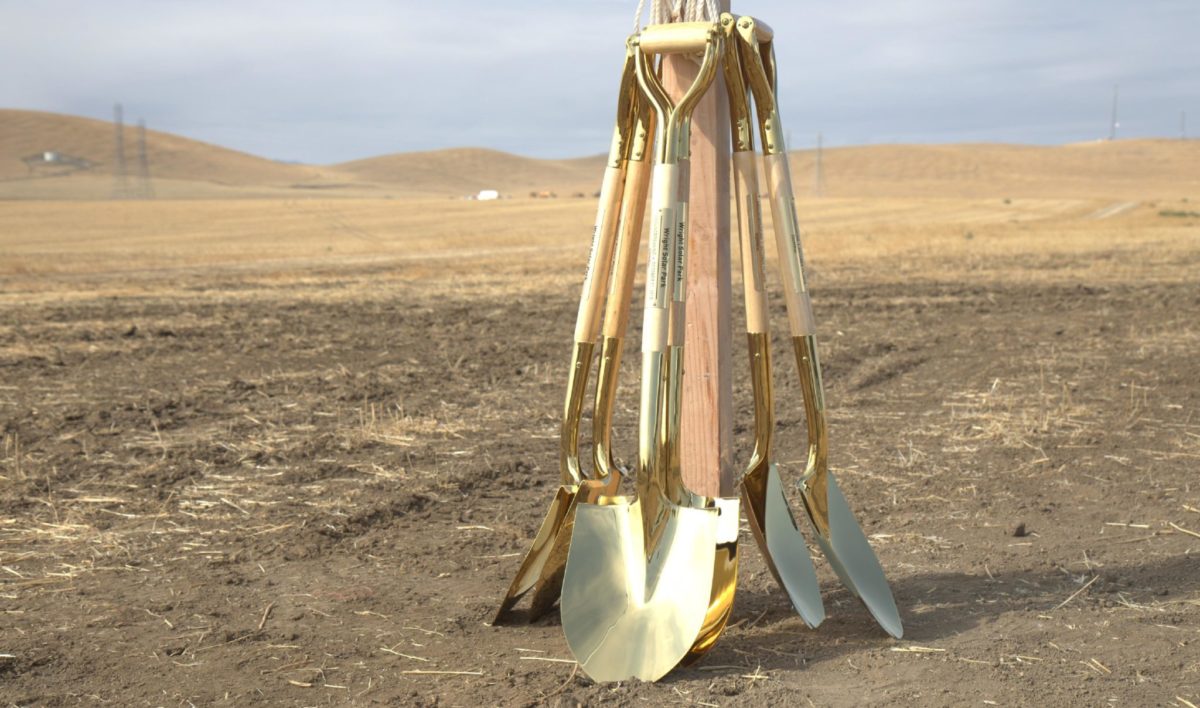200 MW-AC is a lot of solar panels. Depending on the wattage, the Wright Solar Park could use as many as 600,000 PV modules, mounted on NEXTracker single-axis trackers.
Following a groundbreaking day, construction contractor Clēnera is officially beginning work on this project, which occupies 1,200 acres of former grazing land in the rolling plains of Merced County, in California’s Central Valley.
When the plant goes online in late 2019, the electricity will flow directly to Silicon Valley. Well, not exactly, because you can’t disaggregate electrons. But the entire output of the project is being sold to Peninsula Clean Energy (PCE) on behalf of the residents of San Mateo County under a 20-year contract, making this the largest solar plant to contract entirely with a Community Choice Aggregator (CCA) to date.
More steel in the ground
CCAs are a mechanism under which local governments – in this case, the cities located in San Mateo County, California – form an entity to procure electricity for their communities. And while CCAs are allowed in six states, they have rapidly multiplied in California as a way for cities and counties to procure electricity that is even cleaner than the 60% renewable energy by 2030 that is currently mandated by the state.
PCE offers as its default product to country residents a 50% Renewable Portfolio Standard (RPS) – compliant renewable energy, plus another 35% power from large hydro plants, which do not qualify for California’s RPS. For an extra fee, households and businesses can subscribe for 100% RPS-compliant renewables.
CEO Jan Pepper says that PCE is getting this power from a mix of short-term contracts with several wind projects and one solar plant, and has also signed a longer-term contract with the 100 MW Mustang Solar project. She notes that while the short-term contracts helped to get the numbers up, PCE is prioritizing long-term contracts to help new projects like the Wright Solar Park get off the ground.
“One of the things that we are very interested in is additionality: making sure that what we are doing is putting more steel in the ground,” explains Jan Pepper.
With this project and others, Pepper plans for PCE’s electricity supply to emit no carbon in 2021 – 24 years before the date set by the state’s recent mandate. By 2025, she plans to transition the entire fleet to 100% RPS-compliant renewables.
A contested transition
“Our goal is to accelerate the state’s energy goals,” notes Pepper. She is not alone. In California CCAs at either the county or municipal level are currently active in 17 counties, including some of the state’s biggest cities, and represent an increasingly large portion of the state’s load.
This proliferation has not gone unnoticed by investor-owned utilities nor regulators. Michael Picker, the chair of the California Public Utilities Commission (CPUC), has expressed concern over the issues that this raises for the state’s utilities and electricity system.
And while CPUC’s jurisdiction over CCAs is limited, these entities are still required to meet local resource adequacy requirements, which PCE reports that it is compliant with. A thornier problem for CCAs is that under enabling legislation they are responsible for ensuring that remaining utility customers do not see cost increases.
In June CPUC opened a proceeding to investigate the Power Charge Indifference Adjustment (PCIA) that CCAs must pay, and is expected to issue an order on that ruling today. This proceeding has been sharply contested, with the mayors of San Francisco, Oakland and San Jose issuing a joint statement describing the process as “rushed, opaque and (showing) little concern for rate-paying customers”.
pv magazine USA will report on the results of this proceeding today. Either way, we do not expect the move to CCAs to slow down. As the Wright Solar Park shows, CCAs are entering the big time, and there is no going back.
This content is protected by copyright and may not be reused. If you want to cooperate with us and would like to reuse some of our content, please contact: editors@pv-magazine.com.









By submitting this form you agree to pv magazine using your data for the purposes of publishing your comment.
Your personal data will only be disclosed or otherwise transmitted to third parties for the purposes of spam filtering or if this is necessary for technical maintenance of the website. Any other transfer to third parties will not take place unless this is justified on the basis of applicable data protection regulations or if pv magazine is legally obliged to do so.
You may revoke this consent at any time with effect for the future, in which case your personal data will be deleted immediately. Otherwise, your data will be deleted if pv magazine has processed your request or the purpose of data storage is fulfilled.
Further information on data privacy can be found in our Data Protection Policy.